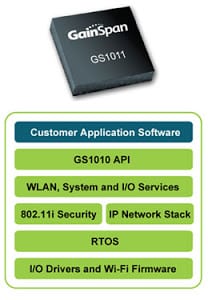An interview with Bernard Aboussouan digging in deeper behind Gainspan’s latest emebedded hardware options

Low power embedded Wi-Fi chips, modules and software.
The people behind Gainspan (a spin-off of Intel in 2006) are predicting the low power Wi-Fi device market is going to grow dramatically over the next few years and are positioning their suite of low power chips, modules and embedded software stack as a way for companies to quickly enable their products to join the Internet of Things.
Up until recently full fledged 802.11b Wi-Fi communication on low powered devices was considered out of the question due to extensive resource limitations on software, memory and energy requirements.
The possibility for Wi-Fi on low powered devices is now a reality due to recent advances with SoC (system-on-chip) designs, new protocols, and energy saving techniques which are allowing this widely adopted standard to be used on devices able to be deployed for years without needing to change batteries.
I recently spoke with Bernard Aboussouan, a VP at Gainspan about their technology and how companies are using it. Our interview is below:
Can you tell me first tell me a little about your background:
I’m currently the Vice President of marketing at Gainspan where I joined the team at the end of 2008. Previously, I was at Sequans Communications a company that had an IPO this year and works on creating LTE and WiMAX chipsets. Before that I worked at different companies all involved in telecommunicaions (Harris, Nortel Networks on the microwave radio side) and then most recently in California I had been at BeamReach Networks and finally here at Gainspan.
How is your company enabling an Internet of Things?
I will give you a little history first. GainSpan was a spin-off of Intel in 2006 and at that time our CTO, who was a long time Intel employee, felt that we could do with Wi-Fi what people were trying to do with ZigBee. The real enabler of the Internet of Things is Wi-Fi. Wi-Fi has the Internet connectivity and all the standards behind it including the IP stack, whereas ZigBee is/was working on moving towards an IP stack.
So the idea was, let’s provide the Internet, let’s provide the connection, and let’s enjoy the benefits of the fact that Wi-Fi is already deployed on so many devices. Since then GainSpan has been focusing on the Internet of Things, and providing connectivity with a chip and module that can run off of a battery for multiple years.
Typically the first question a customer asks us is, “how do you compare against other technologies (ZigBee, 6LoWPAN, Zwave etc)”? One of the big benefits of Wi-Fi is if you take an iPhone, Android, etc Wi-Fi is already enabled on them. Some of our customers today are trying to enable full connectivity to the Internet, but many of our customers start with just connecting to other devices. For example, we have been working withTanita (a leading manufacturer of body mass index monitoring devices, weight scales,etc) and other companies who manufacture home healthcare devices that monitor glucose levels, heartrates, etc. These devices are not typically Internet enabled. The first connectivity piece is to send the monitored data from the device to a PC or a smartphone.
The next connectivity aspect is now to take the data that was sent to a smartphone/PC and send it to the Internet. For example, say you need to take your blood pressure every day. If you can send this information to your doctor easily and securely over the Internet it can be very powerful. Your doctor can monitor your condition in near real-time and ensure that your pressure is okay or make needed adjustments. Once you start adding this component you want to consider many other dimensions, such as making sure it’s over a secure network, etc. Today we can manage many of those issues with Wi-Fi,whereas it’s more complicated to do with ZigBee since ZigBee lacks a full-fledged IP stack.
Now that the customer understands the value of Wi-Fi, the next question they ask us is “how do you compare to other Wi-Fi providers”?. We have two sets of competitors. The first set of competitors are what I call the traditional Wi-Fi vendors like Qualcomm/Atheros, Broadcomm, and Marvell whose products typically go into phones, laptops and PC’s and are not focused on low power. The other competitors are those who pretend to be low power and whose products are used for sensors or deeply embedded applications. Where we shine compared to traditional Wi-Fi vendors, is for devices that typically spend most of their time sleeping and occasionally wake up to send information. Perhaps you need to send data once a minute, or track assets which might send data every 15, 30 seconds. Portable printers, sensor networks, point-of-sale terminals are a few examples of such devices that only need to send data intermittently and where power consumption is important and you need your battery to last as long as possible. We have several modes of low power. On our lowest power setting, for example, we consume power in the single digit microamps whereas our competitors are consuming hundreds of microamps, if not milliamps, of power.
This is actually how I discovered your company is through researching WSN energy harvesting.
Over the years we have dealt with some elements of energy harvesting, and have done a number of demos through temperature or vibrations that have shown our devices are capable of being energized this way. We have dealt with AdaptivEnergy in the past, and more recently, we have been doing some interesting things with a company called Perpetua which works with temperature gradients.
Can you tell us about your networking stack?
Yes, that is another way we differentiate ourselves. We provide a full TCP/IP stack. We actually go quite high up in the networking stack by providing a Restful architecture: HTTP/HTTPS, Bonjour for discovery,etc. All of these things are provided on our chip/module allowing customers to set up applications in a simple way so they don’t have to worry about Wi-Fi or networking connectivity for their project.
How would discovery of a device work with this technology?
Some of the embedded devices that are being developed today basically have no human interface. Take an example of a smart plug. There’s no way to interface to it, so how do you control the device? With GainSpan embedded Wi-Fi the smart plug can come up as an access point. So if you turn on your iPhone/smartphone you will be able to discover the smart plug device nearby and through a webpage hosted on our chip/ module you can ask it to join a given network. So the smart plug turns from being an access point into a client of another network.
We have paid a lot of attention to the whole aspect of provisioning, allowing developers (and ultimately our customers) to really have a device that is easy to provision. One of the standard ways to provision in Wi-Fi is calledWPS (Wi-Fi Protected Setup) where you have two modes of operation. One mode: the push button mode is similar to Bluetooth where you pair your earpiece to the phone, you push a button on a device and they pair themselves together. Alternatively, in the other mode, the pin method you could enter a pin number (typically in the form of a label on the device) at the access point, basically saying if a device has that pin number you should be able to talk to it. We also provide the access point mode mentioned earlier that allows any device to come up as an access point and then be turned into a client of another access point.
Can you tell us more details about your chip and modules?

Most of our competitors typically rely on the host for networking whereas with GainSpan our entire stack is sitting on the chip and module. Other solutions associate the module with a host and the host basically has to run the networking stack and WPS. Fundamentally you are consuming resources on the host microcontroller. In our case, however, the host microcontroller’s only job is to support the customer’s application. It doesn’t have to handle any of the networking stack because the networking stack is handled by our chip. With our module/chip we offload the entire process for networking and connectivity. The only thing that needs to be developed on the host microcontoller is the customer’s application. This is very important because as you deal with smaller and smaller hosts (for example if you have an 8 bit microcontroller with limited memory and RAM, that host can’t handle a full networking stack) it gives customers the flexibility to select any hardware they want and we can connect any them. With other solutions the customer would basically be forced to use a 32 bit microcontroller that had enough horsepower and memory to be able to handle the networking — and that would change from one microcontroller to another.
What sets GainSpan apart is power consumption and all of this networking ability. Our package handles all aspects from the full network stack, TCP, XML parser, to discovery and security. All of these are included and is where we are adding value.
Since your product is actually enabling an Internet of Things do you have a working definition for the term within the company?
For us the Internet of Things is, in essence, taking any small device and connecting it to the Internet. That can go as far down as to a dumb simple sensor, a brainless device to which you are bringing connectivity. When we talk about such a device in the home, for example, we’re talking about things like a coffee machine or rice maker. The type of applications our customers are doing is almost infinite.
We have one customer who developed a Wi-Fi enabled barbecue. Okay, you say, why would you want to do this? In this case he is not connecting it to the Internet, rather he wants to use it to accurately monitor and control the airflow in the BBQ and temperature of the meat. He has an application on his IPhone that monitors all of the sensors–he can raise the temperature if he sees it’s not hot enough, he can activate the blowers inside the barbecue if need be, and if he is in the kitchen it allows him to watch all of those things and control them very precisely without going outside.
Two markets in which we’ve seen a great deal of success are health care and smart energy. I mentioned blood pressure, weight, heart rate and recently BMI devices. Another example in the health care sector is a customer who is creating Wi-Fi slippers. Embedded in the sole of each slipper are 4 pressure detecting sensors that can monitor if something is wrong, such as someone losing stability. So a home healthcare worker, for example, could use this data to recommend taking certain measures, send help to them, or prescribe other measures.
To a certain extent Wi-Fi is to sensors what the Web is for us today. You can’t start by figuring out what the killer app is going to be, you have to make it available and see what people can imagine.
So whats next for Gainspan?
In this market we are going to see good growth (this year we’ve seen quarter to quarter growth of 50%) and more and more demand. Initially we started with smaller types of customers and now we are seeing that shift into Tier 1 type of customers. In the past we often saw Tier 1’s promoting other types of wireless technology; now they are starting to see the benefits of using Wi-Fi for their devices.
We have been spending a lot of time on Smart Energy and Health Care to build the stack to make it richer to meet the needs of the applications. It’s not only embedded Wi-Fi, but it’s also connecting it to the network. Enabling the application and making it easier to provision for the user, discovery mechanics, and making it all very simple. From Gainspan’s perspective it’s about making it easier for our customers to develop their applications and reducing their time to market.
Thanks for taking the time to talk to us Bernard.





